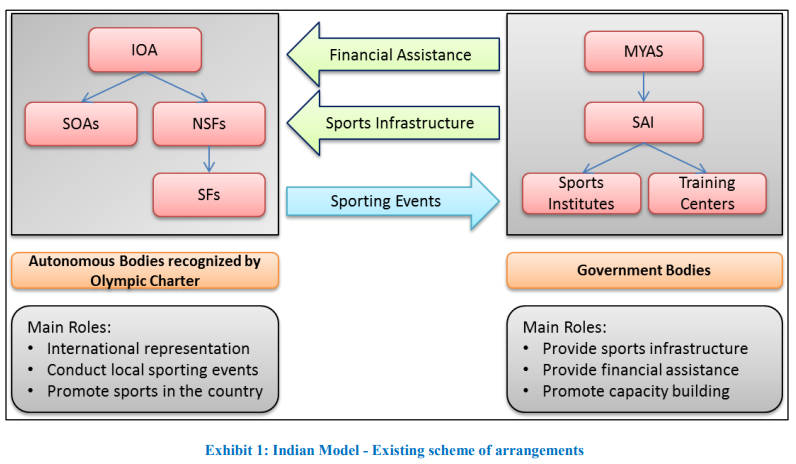Sports Governance in India
2023 MAY 4
Mains >
Governance > Aspects of Good Governance > Governance
IN NEWS:
- The ongoing protest by elite wrestlers has raised discussions on the bad governance in Indian sports.
CURRENT INDIAN MODEL OF SPORTS GOVERNANCE:

- ‘Sports’ being a state subject, the responsibility for development of sports rests with the State/Union Territory Governments. Central Government supplements their efforts in this regard.
- In accordance with the Olympic Charter that restricts government influence of sports federations, the sports bodies in India are autonomous entities.
- The Indian Olympic Association (IOA) is the umbrella body under which all the National Sports Federation (NSF) and State Olympic Association (SOA) conduct various sporting events in the country.
- Government bodies operate under Ministry of Youth Affairs and Sports (MYAS) facilitate training and infrastructure management.
- In addition, there are federations for non-Olympic sports such as Board of Control for Cricket in India (BCCI) for cricket. These federations are directly affiliated to their respective international federations.
- All the sporting governing bodies are registered as societies under the Societies Registration Act, 1860.
ISSUES IN INDIAN SPORTS GOVERNANCE:
- Weak organisational structure:
- Many of the organisations lack the professionalism needed to develop a competitive sports industry. Eg: In many sports federations, the executive committee — the body responsible for governance —is also doing the management works.
- In some cases, there are multiple governing bodies, leading to governance paralysis. Eg: The tussle between Hockey India and Indian Hockey federation in early 2010s.
- Unaccountability:
- In the pretext of autonomy, the current model of governance is opaque and lacks effective checks and balances. This creates an environment conducive to wide-scale corruption, nepotism and fiefdom.
- Eg: 2010 Commonwealth games scam
- Eg: The IOA was suspended in 2012 from the International Olympic Committee (IOC) for electing members with pending criminal cases against them in its governing body. This forced Indian athletes to compete at the Sochi Winter Games under the IOC flag, instead of the Indian banner.
- External interference:
- Sports federations and associations in India function in a very political manner having office bearers as politicians or businessmen. This has often attracted action from international sports bodies.
- Eg: The All India Football Federation was recently suspended by FIFA due to “third-party interference”.
- Duplications in policy:
- Due to lack of coordination among the agencies, there are instances of duplication in policy measures.
- Eg: Both the Samagra Shiksha Abhiyaan and Fit India Movement are called upon to provide sports equipment to government schools and ensure maintenance.
- Issue of sexual harassment:
- A recent finding revealed that 16 of India’s 30 national sports federations do not have an Internal Complaints Committee (ICC), a legal requirement under the Prevention of Sexual Harassment (PoSH) Act, 2013.
- Nominal government spending:
- The total allocation for sports in the Union budget 2022-23 stood at Rs 3062.60 cr, while China spends around 200 times more.
- Influence of illicit activities:
- Indian sporting arena has often been a victim of doping, match fixing and money laundering.
- Eg: The 2013 Indian Premier League spot-fixing and betting case
WAY FORWARD:
- Create an independent regulator:
- An independent sports regulator called Sports Regulatory Authority of India (SRAI) could be created, with a role similar to that of SEBI and TRAI. It should ensure that sports governance in India is in accordance with the rules, regulations and best practices.
- Reform sports federations:
- Federations should be made more accountable and transparent by ensuring regular elections, audits, disclosures, and grievance redressal mechanisms.
- NSFs should also be made more professional and competent by hiring qualified staff, adopting best practices, and enhancing their capacity building.
- Inclusive governance:
- Sport governance bodies should be made more inclusive and representative by ensuring gender parity, regional diversity, and stakeholder participation.
- Recognise Sports as an Industry:
- In a fast-growing economy like India, there is a tremendous potential for the sports sector to develop and achieve the status of an industry.
- Create a sports culture:
- Society’s attitude towards sports is the biggest stumbling block in improving sports in the country. The change has to begin from the primary education level to build a sporting culture in the country. This should be supplemented by investments in sports infrastructure.
PRACTICE QUESTION:
Q. Governance reforms are crucial if sports is to emerge as an important industry in India. Discuss.
